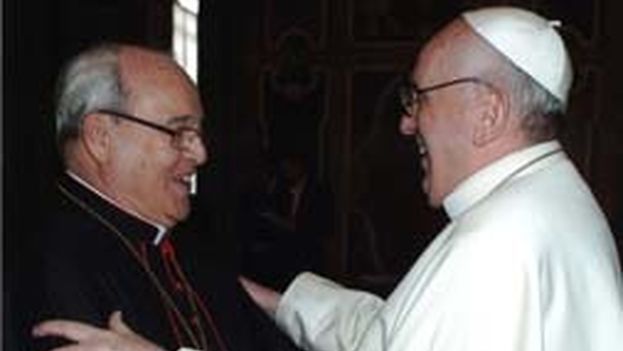
![]() EFE, Sara Gómez Armas, Havana, 18 September 2015 — Pope Francis is the third pontiff to visits Cuba, a country where the Catholic Church has assumed an important role as mediator with Raúl Castro’s administration, but which still faces challenges as it tries gain more space and institutional recognition on the Communist island.
EFE, Sara Gómez Armas, Havana, 18 September 2015 — Pope Francis is the third pontiff to visits Cuba, a country where the Catholic Church has assumed an important role as mediator with Raúl Castro’s administration, but which still faces challenges as it tries gain more space and institutional recognition on the Communist island.
Cuba is one of the few countries in the world that has been visited by three consecutive popes: John Paul II in January 1998; Benedict XVI in March 2012; and from Saturday to Tuesday, Jorge Bergoglio, the first Latin American pontiff.
During his four days in Cuba, Pope Francis will visit Havana, where he will celebrate Mass at the Plaza of the Revolution, and meet with Raúl Castro. He will visit Holguín, a province that will receive a pope for the first time, and will also visit Santiago de Cuba Province, where he will visit the Shrine of Our Lady of Charity of El Cobre, the country’s patroness.
The Pontiff will depart Santiago for Washington, the second part of his visit to Cuba and the United States. These two countries restored ties after 54 years of hostilities with Francis’ personal mediation, thus giving a political and diplomatic dimension to this pastoral visit.
Accompanied by the catchphrase “Missionary of Mercy,” Francis is travelling to a Cuba that is very different than the one John Paul II encountered. That occasion was a historical milestone in the rapprochement between the Church and State after decades of disputes and tensions between the latter and the Castro Revolution.
Karol Wojtła’s visit – during which he was accompanied by then-bishop Jorge Bergoglio – marked a “before and after.” According to Father José Félix Pérez, spokesperson for the Catholic Bishops Conference of Cuba, John Paul II’s visit “gave public visibility and renewed energy” to the Cuban Catholic Church.
Subsequently, a reformist Raúl Castro reinforced this rapprochement. In power since 2008, Castro took the significant step of committing to the release of political prisoners after his unprecedented dialogue with the country’s Catholic hierarchy in 2010. Father Pérez added: “We now have better communication. It’s more fluid. We share a very positive, cordial spirit.” This assessment is shared by the ruling Communist Party of Cuba. According to a recent interview given to EFE by Caridad Diego, Director of the Religious Affairs Office of the Communist Party, the latter’s relations with the Church are at a “good level.”
As part of this détente, the State has returned churches, buildings, and land that was property of the Catholic Church which had been expropriated by the Revolution. Furthermore, the Cuban government has for the first time since 1959 authorized the construction of two new churches, one in Havana and the other in the western province of Pinar del Río. Likewise, nuns are now being allowed to attend to the sick in hospitals, and to senior citizens in a country facing the challenge of an increasingly aging population.
Nevertheless, the Church is calling for more public spaces allowing it direct contact with the people, such as in the area of education. It is also asking for more access to the media, which on the island are owned by the State.
In the area of education, the Church has been developing since the end of the nineties ninety adult education courses. Since 2012, roughly 500 Havana entrepreneurs have benefited from the “CubaEmprende” (“EntrepreneurialCuba”) program, which aims to train the self-employed how to run their businesses.
The growth in the island’s public sector is one of the measures implemented by Raúl Castro in his reforms aimed at “updating” the island’s Socialist model. The Catholic Church supports this plan, although on occasion it has criticized the slow pace of change.
When taking into account the numbers of baptisms, it is estimated that 60% of Cuba’s population (the island has 11.1 million inhabitants) is Catholic. However, the percentage of Cubans who attend Sunday mass drops to two percent. There are 305 parishes, 357 priests, 776 consecrated religious, 585 women and 191 men, belonging to 96 communities. These numbers are still modest when compared to the presence of the Catholic Church prior to 1959. After the Revolution came to power, 131 priests were expelled from Cuba, and almost 500 “left of their own free will.”
Still, religiosity on the island is distinguished by its syncretism with religions such as Santería, which enjoys great popularity, and whose adherents find no incompatibility with it and Catholicism.
Caridad Diego used the following example. “In Cuba, it is normal for a person who was baptized into the Catholic Church to be initiated into Santería, make animal sacrifices, perform Abakuá rituals, and on top of that, be a Freemason as well.”
According to the data of the Office of Religious Affairs of the Communist Party, there are 55 officially recognized and registered Evangelical and Protestant denominations in Cuba.
